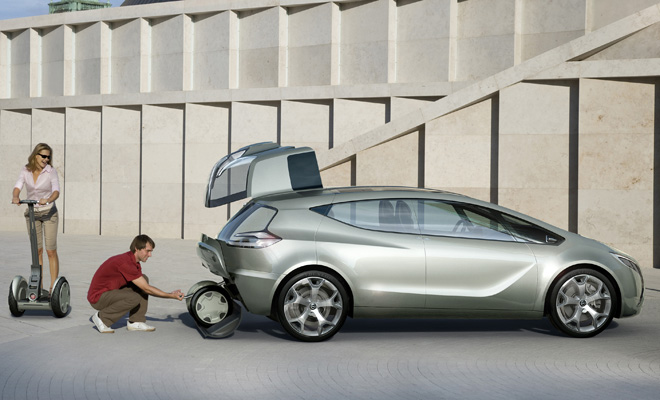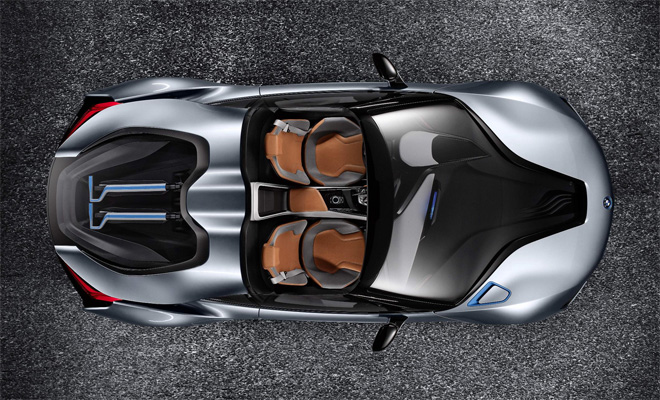by Lem Bingley 
The 2013 Frankfurt Motor Show started this week, and one of my favourites among the many delights on show is the Smart FourJoy. This is presumably a disguised preview of the upcoming ForFour city car, due late next year, by which time it will no doubt have gained a roof and some doors. Though given that Smart did once put a skeletal, roofless car on sale in the shape of the 2002 Crossblade, you never know.
However it turns out, the 2014 Smart ForFour looks certain to be a more persuasive car than the old 2004 five-door model, which really wasn’t very Smart, seeming to be nine-tenths a Mitsubishi.
With a battery-electric drive based on hardware from the ForTwo ED, the FourJoy concept offers zero emissions along with its zero protection from the elements. However, the boot has been adapted to carry a pair of helmets, and the top of the car features mounting points for two electric skateboards. These are, according to Smart, for completing the “last mile” of your urban journey.
It doesn’t seem likely that the skateboards will feed through to production, to become optional extras for the finished ForFour. But the FourJoy won’t be the first dual-mode concept to be dangled in front of us and then whipped away by reality.
Below are my five favourite concept cars with a little something on board to get you from the park-and-ride to the city centre, without the need to wait for a bus.
 Honda EV-N and UX-3
Honda EV-N and UX-3
At the 2009 Tokyo Motor Show, Honda showed off the charming EV-N, a cute and compact four-seat electric car that paid homage to the company’s classic N360 micro car of the 1960s. Strapped snugly inside one of the doors, the EV-N carried Honda’s remarkable UX-3 personal mobility device.
The UX-3 is a self-balancing electric unicycle with a clever hidden party piece. The tyre of its single wheel is actually not a continuous hoop but a ring of small rubber rollers – which can be spun under power if required – allowing the one-wheeled UX-3 to roll smoothly forwards and backwards but also to zip left or right.
While you might never want to travel crab-fashion, the clever compound wheel does mean the UX-3 can move in any direction to adjust the rider’s balance, so you shouldn’t fall off – even if you are about as well balanced as a Sumo wrestler who’s been on the sauce.
 Opel Flextreme and a pair of Segways
Opel Flextreme and a pair of Segways
Opel’s 2007 Flextreme concept featured petrol-electric running gear from the Chevrolet Volt, previewed the suicide doors of the current Meriva, and donated its face to the Ampera and Zafira Tourer. Alas it hasn’t yet inspired a production car with a pair of folding Segways in the boot.
Equally, the battery powered Segway hasn’t quite triggered the revolution in transportation that its inventor, Dean Kamen, once foresaw. But it did succeed in bringing the notion of small-scale electric mobility to broad public attention. And a Segway did once send George W Bush tumbling ignominiously to the ground, which has to be worth something.
 BMW i3 and i-Pedelec
BMW i3 and i-Pedelec
In June 2012, BMW opened the first showroom for its new BMWi brand on London’s Park Lane, and used the occasion to show off a version of its i3 electric car, adapted to carry a pair of folding electric bicycles.
BMW’s i-Pedelec is 20kg bicycle designed to offer 250 watts of pedalling assistance at speeds up to 16mph, providing a range up to 25 miles. The i3 was adapted to allow the bike’s 300Wh lithium-manganese battery to charge at the same time as the car’s own rather larger battery, or to borrow a little energy from the car’s own stores if needed.
The i3 is now on sale, with UK deliveries due to begin in mid-November, but alas the i-Pedelec doesn’t seem to be destined for production – never mind as a plug-in accessory for the i3.
 BMW i8 and electric scooters
BMW i8 and electric scooters
A couple of months prior to the bike-backed i3, BMW showed off a Spyder variant of its i8 plug-in hybrid at the 2012 Beijing Motor Show. The roofless concept featured a pair of folding electric scooters mounted under its transparent bootlid, above the midship location of the hybrid’s three-cylinder engine.
The battery-powered three-wheeled scooters were fashioned from carbon-fibre, evidently designed to echo the construction of the i8 itself, but sadly few other details of the scooters were revealed.
The first day of this year’s Frankfurt Motor Show saw the debut of the i8 coupe in production form. And while it retains dramatic upward-opening doors, a carbon-fibre tub and an advanced combination of petrol and plug-in power, the scooters have alas gone missing.
 Honda Micro Commuter Concept and electric Motocompo
Honda Micro Commuter Concept and electric Motocompo
Amazingly, Honda did once put a dual-mode concept into production – selling a tiny folding motorcycle called the Motocompo in the early 1980s that was designed to fit in the boot of the contemporary Honda City hatchback. The car was a success, the bike less so, but that didn’t stop Honda returning to the idea for the 2011 Tokyo Motor Show.
The company’s space-age Micro Commuter Concept adopted a three-seater arrowhead interior, making room for an updated electric Motor Compo next to the driver.
While the usefulness of a carry-along miniature motorbike is obvious, the 2011 Motor Compo went a step further. It featured a detachable power unit complete with domestic outlets, designed to charge while docked in the car, offering true go-anywhere power.
While the Micro Commuter Concept has been toned down and seems set for production, there has been no further word on its cute little brother. Here’s hoping that Honda won’t have been so burned by its 1980s experience with the Motocompo that it puts the modern version on ice.
Electric Smart FourJoy joins the last-mile club
11 September 2013
Read more about: BMWi electric cars Frankfurt 2013 Honda Opel Smart Vauxhall



